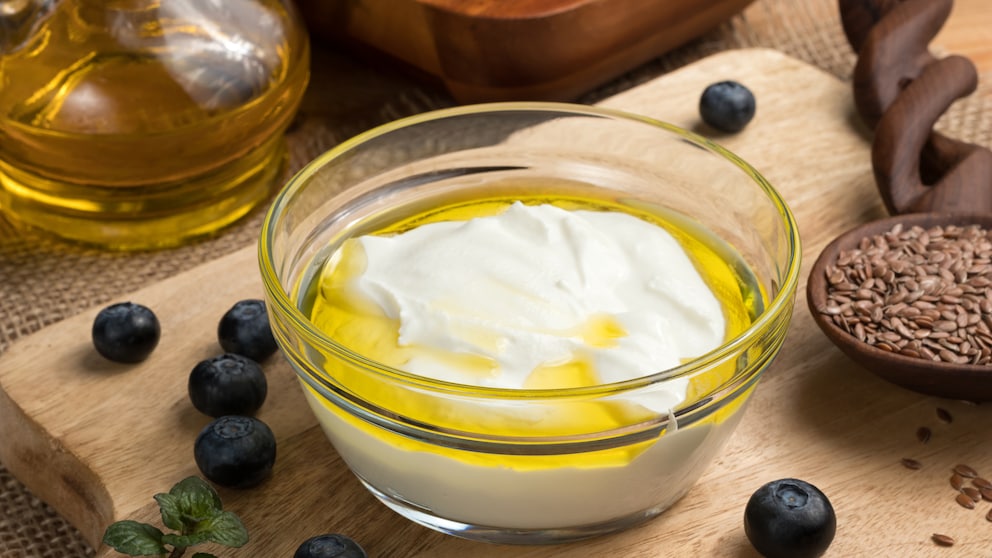March 1, 2025, 2:32 pm | Read time: 3 minutes
Quark (curd cheese) with linseed oil is not a new social media trend. The so-called “oil-protein diet” was invented by the natural scientist Johanna Budwig back in the middle of the 20th century. Although her hypothesis that the diet could help against cancer has never been proven, this combination still has its raison d’être today in many other respects: it helps you get through the day without cravings if you want to lose weight — and protects your muscles in the process.
Adding an extra spoonful of oil to low-fat quark might seem counterintuitive for weight loss at first glance. Why eat a low-fat quark when the linseed oil makes up for the calories saved? However, this combination packs a punch: it’s become a valuable way to kickstart the day for those looking to shed pounds, particularly at breakfast, and it’s also advantageous as a post-workout snack. Discover which nutrients make quark with linseed oil a healthy choice and learn the important considerations for using the oil.
Overview
What’s Inside
For weight loss, it’s ideal to begin your day with a breakfast that’s filling, protein-rich, and calorie-conscious. Let’s assume you eat 250 grams of low-fat quark in the morning and stir in a tablespoon of linseed oil. This portion would then have the following nutritional values:
One immediately noticeable advantage is the high protein content. It is particularly important in a diet to keep you full for a long time and to protect your muscles from breaking down. This is because our body has a specific protein target that it wants to achieve every day. It should be around one gram of protein per kilogram of body weight per day (more precisely, 0.8 grams). However, a word of caution: if you’re overweight and aiming to slim down, you should base this calculation on your target or ideal weight rather than your current weight!
By the way, you are welcome to add some fruit, oat flakes, or nuts to your quark and oil dish. This will not only make it taste better but will also provide you with filling fiber and important vitamins. Another option is to add the linseed oil to herb quark with jacket potatoes.
How Linseed Oil Helps You Lose Weight
Returning to the topic of linseed oil, which accounts for a significant 133 calories of the total mentioned earlier — how does this contribute to weight loss? Well, quite simply, thanks to the fat, the protein is digested more slowly, which means that insulin is also released more slowly. As a result, blood sugar levels stay stable for an extended period, reducing the likelihood of experiencing cravings.
And there is something else that makes linseed oil special: it consists of 53 percent alpha-linolenic acid. This is an essential omega-3 fatty acid that the body cannot produce itself. It also has an anti-inflammatory effect on the body. This is important not only for muscle regeneration and the prevention of arteriosclerosis and the resulting cardiovascular diseases but also for reducing obesity. In the case of severe obesity, there is chronic inflammation in the fatty tissue, which can disrupt the metabolism and complicate weight loss.3 This can lead to insulin resistance, for example, as a result of which the regulation of the feeling of hunger no longer functions properly.

Expert Weighs In An Overlooked Fish Species That Is Extremely Healthy

Nutrition tips from an expert 5 healthy snack recipes that keep blood sugar levels down

Nutrients 5 nuts that can help you lose weight
Using and Storing Linseed Oil Correctly
The primary rule to remember is to never heat linseed oil! Not only does it lose its beneficial properties at high temperatures, it can also produce harmful trans fatty acids. Unlike other edible oils, linseed oil should be stored in the fridge as it goes rancid more quickly due to its high omega-3 content. Once opened, you have around one to two months to use it up. This is why linseed oil is often sold in smaller bottles. If you buy larger quantities, you can freeze some of the oil to extend its shelf life.4

